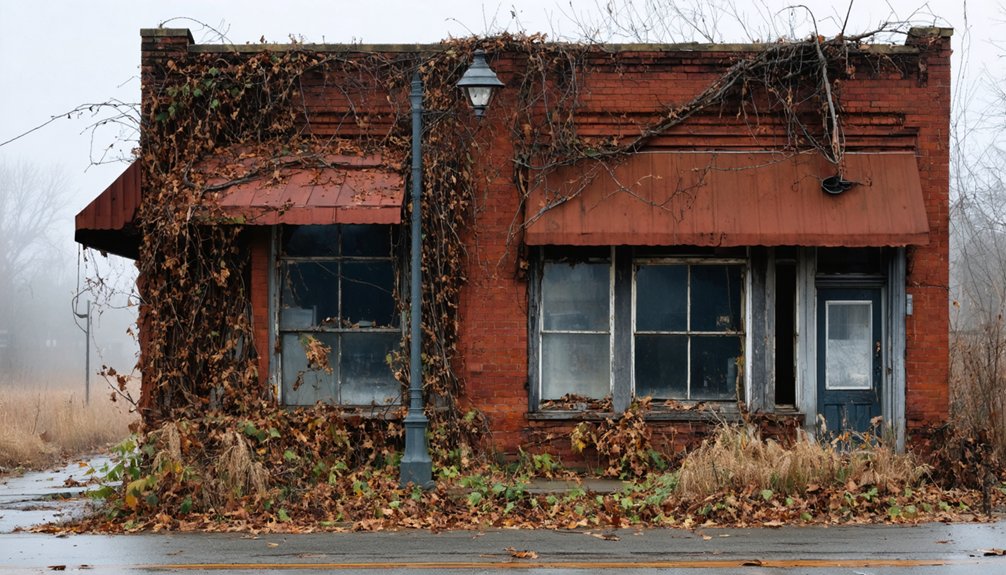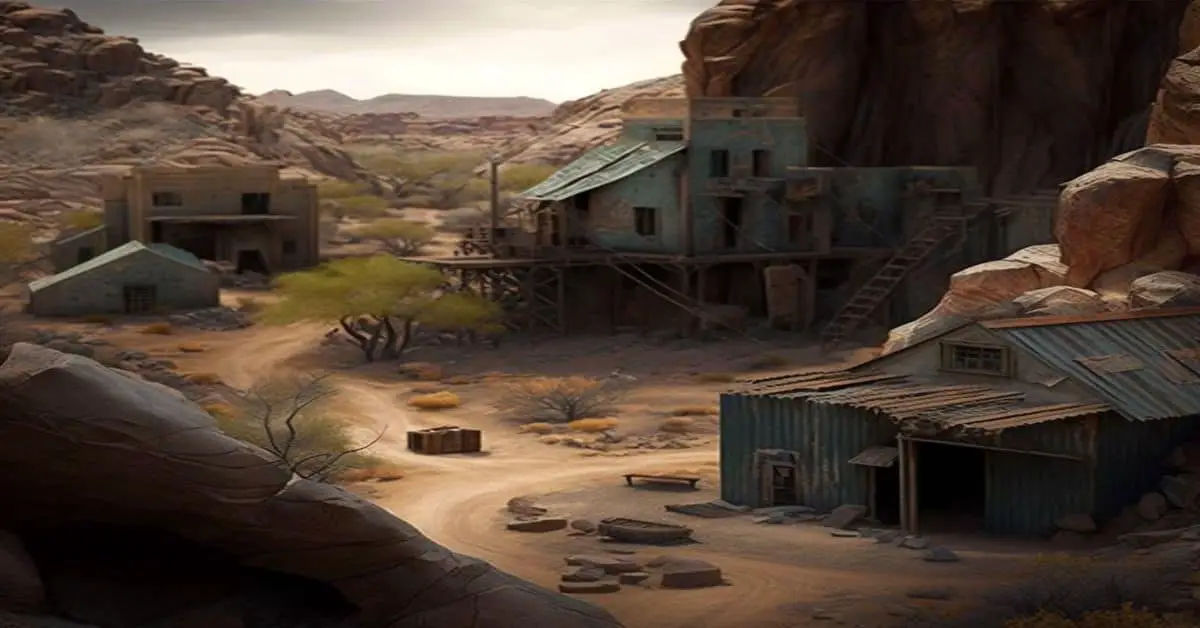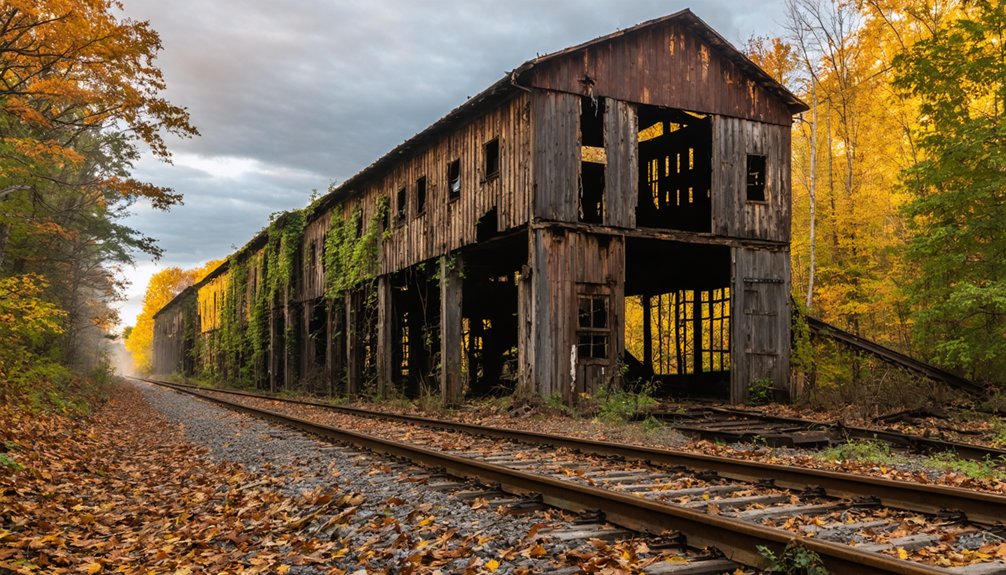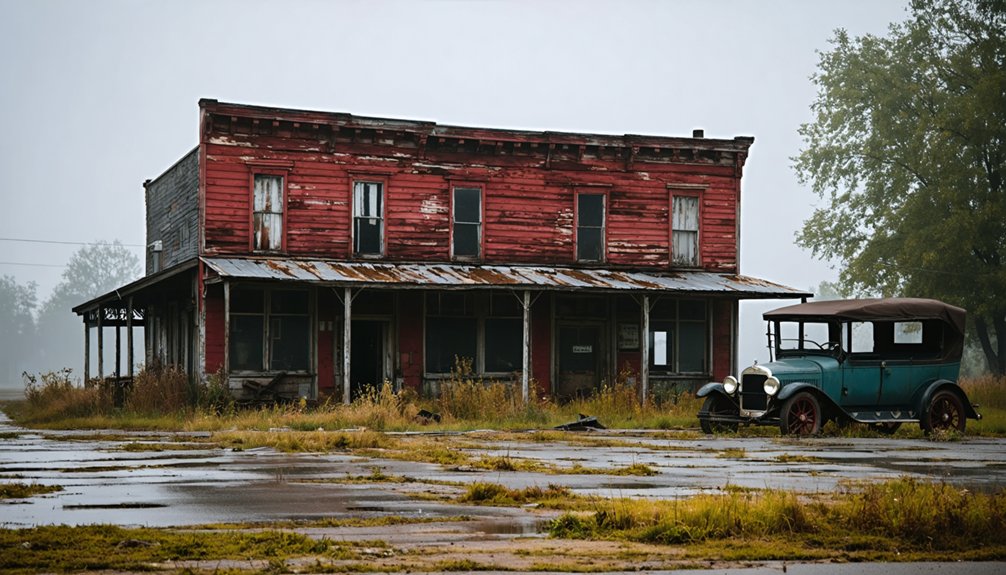You’ll find Baltimore, Indiana along the historic Wabash River, where it once thrived as a bustling river port established in 1837. The town’s fortunes declined when railroads bypassed it and river trade diminished, leading to its eventual abandonment. Today, a single 1880s brick house stands as the last remnant of this ghost town, which saw its population dwindle from its peak to just 70 residents. The story behind this solitary structure reveals fascinating chapters of Midwestern pioneer life.
Key Takeaways
- Baltimore, Indiana was established in 1837 as a river town for trade along the Wabash River, modeled after Maryland’s Port of Baltimore.
- The town’s decline began with the arrival of railroads that bypassed the area and the construction of the Wabash and Erie Canal.
- Only one 1880s brick house remains as the last structure of Baltimore, Indiana, serving as a testament to the ghost town’s history.
- Baltimore’s population dwindled to 70 residents as river trade diminished and agricultural markets shifted toward larger agribusinesses.
- The town joins 41 other ghost towns in Indiana, with its legacy preserved through the solitary house and original road layouts.
The Rise and Fall of a River Town
While many Indiana river towns rose and fell with changing transportation patterns in the 19th century, Baltimore’s story particularly exemplifies this historical cycle.
You’ll find its origins in 1837, when pioneers recognized the Wabash River’s potential for riverboat navigation and trade. Much like Maryland’s Baltimore, which established its Port of Baltimore in 1706, this Indiana town embraced river commerce as its economic foundation.
At its peak, Baltimore buzzed with economic energy. The town served as an essential shipping hub where community gatherings centered around the arrival of riverboats laden with goods.
Local farmers and merchants relied on Baltimore’s wharves and warehouses to connect with broader markets.
But when railroads emerged as the dominant transportation mode, Baltimore’s fortune quickly reversed.
As rail lines bypassed the town, businesses relocated, population dwindled, and the once-thriving river port gradually transformed into an unincorporated community, marking the end of its brief but noteworthy chapter in Indiana’s history. Like many places sharing similar names, the town needed precise geographical identification to distinguish it from other Baltimores in historical records.
Life Along the Wabash
You’d find the early settlers of Baltimore clustered along the Wabash River’s edge, where flatboats served as essential links to distant markets like New Orleans.
Your life would’ve revolved around the river’s seasonal rhythms, with spring floods enabling trade while summer’s low waters meant focusing on local fishing and farming. The river’s steady flow powered local mills, with its white limestone bottom still visible through the clear waters in those days.
In these riverside communities, you’d join your neighbors in seasonal fish harvests while maintaining strong trade connections through local merchants who coordinated flatboat shipments downstream. The construction of each flatboat was a community effort, taking about thirty days to complete.
River Trade and Commerce
Although the Wabash River supported various watercraft, each vessel played a distinct role in the region’s bustling commerce. You’d find packet boats carrying passengers along the canal, like the Silver Bell with its signature silver mules, while line boats hauled essential cargo such as grain, lime, and whiskey.
Locally-built flatboats, taking about 30 days to construct, enabled traders to reach New Orleans via river routes connecting to the Ohio and Mississippi. The crew size ranged from five to ten men depending on the vessel’s dimensions.
The trade networks transformed frontier life, bringing sophisticated goods like silks, parasols, and chinaware to Indiana’s riverside communities. You could see how this commerce shaped local economies, with farmers and merchants profiting from connections to distant markets. A ride on these waterways cost travelers approximately five cents per mile, which included meals and sleeping accommodations.
The Wabash & Erie Canal further enhanced these trade opportunities by linking the Great Lakes to the Ohio River.
Early Settlement Patterns
Before establishing permanent settlements along the Wabash River, pioneers faced intense resistance from Miami and Potawatomi tribes, leading to significant conflicts like the Battle of the Wabash in 1791 and the Battle of Tippecanoe in 1811.
Military leaders like Anthony Wayne and William Henry Harrison eventually secured the region through treaties, opening the land for settlement.
You’ll find that early settlers encountered numerous settlement challenges as they carved out homesteads from dense forests and marshy terrain.
They developed agricultural practices focused on self-sufficiency, clearing land for crops and livestock. These early farmers primarily came from the Upland South region, bringing their cultural practices and farming methods with them. The establishment of mills, churches, and marketplaces created central hubs for growing communities. The Treaty of 1826 formalized the surrender of Native American land rights in northern Indiana, accelerating settlement expansion.
These pioneers relied heavily on the Wabash River for transportation and trade, using flatboats to move goods while building essential roads and trails to connect settlements.
Seasonal Fishing Activities
While the Wabash River has long sustained diverse fishing activities, its seasonal patterns have shaped local traditions since Baltimore’s earliest days.
You’ll find the river’s catch patterns follow distinct seasonal rhythms, with catfish and bass peaking in warmer months, while sauger and white bass runs dominate spring and fall.
The area’s fishing techniques have adapted to these cycles, particularly when targeting northern pike using live shiners during cooler seasons. The river’s varied water depths from just 6 inches to 50 feet require anglers to carefully plan their fishing spots. Many anglers find success using live bait options like creek chubs when pursuing different species.
You can access the river through numerous public boat ramps and shorelines, much as Baltimore’s original settlers did.
Today’s anglers participate in community events like the Wabash Riverfest, continuing traditions of seasonal engagement.
Whether you’re casting from Wabashiki Fish & Wildlife Area or joining local tournaments, you’ll need proper permits and should prepare for variable weather conditions.
Economic Forces Behind the Abandonment
You’ll find that Baltimore’s economic downfall closely mirrored the declining fortunes of river trade along the Wabash, as newer transportation methods made waterway commerce less essential.
The town’s agricultural markets suffered significant setbacks when technological advances in farming reduced the need for local grain processing and distribution centers.
These economic shifts, combined with the broader trend of mechanization in agriculture, left Baltimore struggling to maintain its commercial relevance in the region.
River Trade Decline
Although Baltimore, Indiana initially thrived as a bustling river town in the 1830s, the construction of the Wabash and Erie Canal in the 1840s marked the beginning of its economic decline.
You’ll find that river transport, which once served as the town’s lifeblood, quickly lost its dominance to canal competition. The shift proved devastating for Baltimore’s merchants, including Samuel Hill, whose once-prosperous store saw fewer customers as trade routes changed.
The canal’s superior efficiency and reliability drew commerce away from the Wabash River, and Baltimore’s population of 70 began to dwindle.
With limited economic diversification and heavy reliance on river trade, the town couldn’t adapt to the changing transportation landscape. The post office, established in 1833, stood as a reminder of better days as Baltimore’s prosperity faded.
Agricultural Market Shifts
The decline in river trade coincided with broader agricultural market shifts that further weakened Baltimore’s economic foundation.
You’ll find that the agricultural decline stemmed from multiple forces: mechanization reduced labor needs, while market consolidation favored larger agribusinesses over the small farms that once sustained the town.
Baltimore’s farmers faced mounting challenges as centralized grain elevators and livestock markets in bigger towns diminished local market accessibility.
You could see the impact as transportation improvements enabled farmers to bypass Baltimore entirely, selling directly to urban markets.
The town’s agricultural base eroded further when soil depletion from repeated cultivation without modern management reduced farm yields.
As younger generations left for better opportunities elsewhere, Baltimore’s role as an agricultural hub diminished, accelerating its transformation into a ghost town.
Environmental Challenges and Natural Events
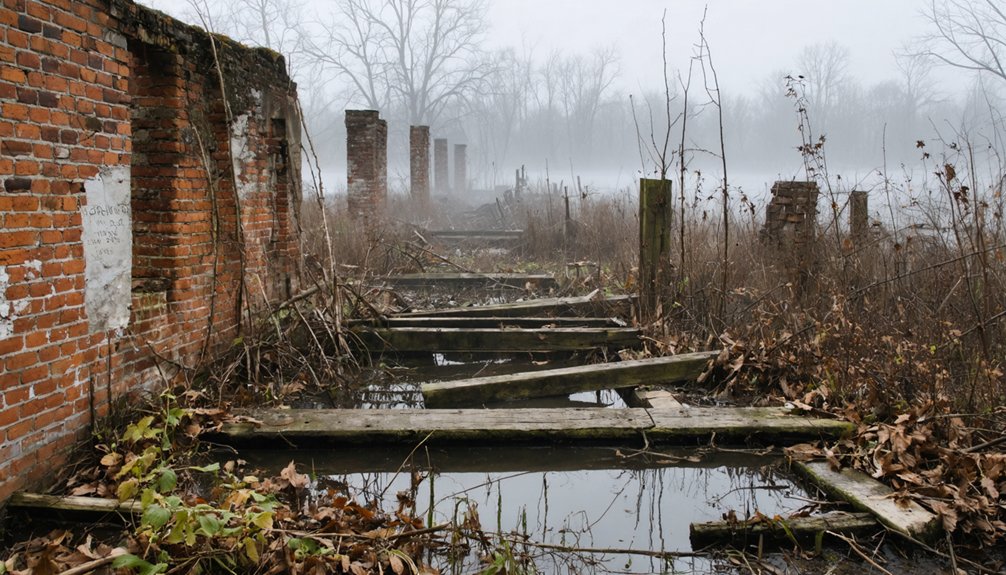
Since the late 20th century, Baltimore’s environmental landscape has suffered from a devastating combination of industrial pollution and climate change impacts.
You’ll find the city’s temperature has risen 2.5°F since 1900, creating longer, hotter summers that intensify urban decay. The environmental justice crisis deepened as industrial toxins from Curtis Bay’s factories left behind brownfields contaminated with lead and mercury.
Today, you’re witnessing the effects of roughly 30,000 vacant properties, where deteriorating structures spread mold and water damage to neighboring homes.
The Patapsco River watershed bears the burden of contaminated stormwater runoff, while rising sea levels threaten waterfront areas.
Heat island effects hit hardest in low-income neighborhoods, where lack of vegetation and extensive concrete surfaces amplify already-rising temperatures.
The Last Standing House
Standing as a solitary sentinel along Baltimore Hill Road, the 1880s brick house is all that remains of a once-vibrant Indiana settlement.
You’ll find its weathered walls bearing silent witness to the town’s rise and fall, from its founding in 1829 through its decline after the Wabash and Erie Canal’s completion.
Between these historic walls lie untold stories of Baltimore’s residents, their daily lives, and the economic shifts that ultimately led to the community’s abandonment.
Silent Sentinel Stands Alone
At the intersection of Baltimore Hill Road, a weathered house rises as the sole surviving structure of Baltimore, Indiana’s extinct townscape.
You’ll find this mid- to late-19th century residence standing defiantly against time, earning its nickname “silent sentinel” through years of solitary watch over the ghost town‘s empty lots.
The house represents more than just weathered wood and aging architecture – it’s a powerful symbol of rural America’s changing landscape.
While historic preservation efforts could save this last physical reminder of Baltimore’s community, its future remains uncertain.
As similar “last houses” across America have shown, these solitary structures often become focal points for community engagement and historical documentation.
Through its isolation, this sentinel continues to tell the story of a once-thriving Indiana town.
Weathered Wood And Time
Time has weathered the solitary brick house at Baltimore’s ghost town since its construction in the 1880s, yet it endures as the final architectural monument to this lost Indiana settlement.
You’ll find it standing near State Road 263 and County Road 1025 South, where weathered bricks tell the story of a town that once bustled with 70 residents and two stores.
Through seasonal changes and harsh Indiana weather, this survivor has withstood over 140 years of exposure.
While wooden structures around it succumbed to time, the brick construction proved more resilient.
Now it overlooks empty fields near the Baltimore and Rodgers Cemeteries, where former residents rest.
Without surrounding development to threaten its existence, nature alone shapes its destiny as a monument to the Midwest’s vanished communities.
Stories Between The Walls
The brick walls of Baltimore’s last house harbor stories spanning generations of Hoosier life.
As you explore its weathered rooms, you’ll sense the whispered secrets of families who once called this place home. Each creaking floorboard and faded wallpaper tells tales of Indiana’s railroad era, when communities rose and fell with the rhythm of passing trains.
Time has transformed these forgotten memories into local folklore, drawing curious visitors seeking connections to the past.
- A crumbling brick chimney stands as evidence to countless winter gatherings
- Worn wooden doorframes mark the heights of children long grown
- Sun-bleached walls hint at pictures that once decorated family rooms
- Empty window frames gaze out at overgrown fields where gardens flourished
- Deep scratches in hardwood floors trace paths of furniture moved by generations
Legacy of a Lost Community
While many Indiana ghost towns boast dramatic stories of natural disasters or industrial collapse, Baltimore’s legacy rests in its quiet fade into obscurity – a sobering reflection of rural America’s broader transformation.
You’ll find no grand ruins or preserved historic districts here, just a solitary house standing as the last relic to a once-thriving farming community.
Baltimore’s story echoes the familiar patterns of rural nostalgia: the shift from small-scale agriculture to modern agribusiness, the exodus of families to urban centers, and the slow erosion of community resilience against mechanization’s tide.
When family farms fade into corporate fields, communities scatter like seeds in the wind, leaving only memories behind.
Unlike Indiana’s “drowned towns” or those struck by disease, Baltimore’s disappearance came gradually.
Today, it joins 41 other ghost towns across the state, its physical remnants continuing to weather away, largely forgotten except by local historians and curious explorers.
Tales From Former Residents
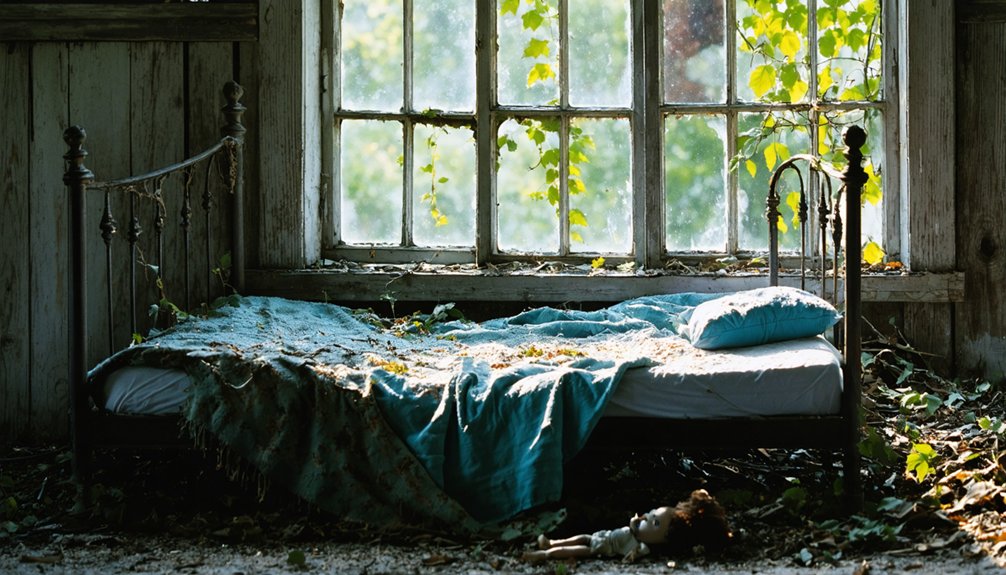
Personal accounts from Baltimore’s former residents paint a vivid picture of a once-bustling riverside community that peaked at 70 inhabitants in the early 1800s.
Through oral histories passed down through generations, you’ll discover how this small but vibrant town thrived on river commerce before the Wabash and Erie Canal altered its destiny.
Community memories reveal a close-knit society where daily life centered around local trade and riverside activities.
- Samuel Hill’s merchandise store represented the county’s largest inventory, valued at $2,500
- Multiple businesses, including Wetzel’s store, served the community’s needs
- The post office operated actively for 32 years until 1865
- River-based commerce sustained families before canal competition
- Residents shared stories of managing hardships as their town declined
Preserving Baltimore’s Memory
Modern efforts to preserve Baltimore’s historical legacy have taken shape through extensive urban renewal initiatives and community-driven programs.
You’ll find memory preservation efforts focusing on both tangible structures and intangible heritage through public-private partnerships and local engagement. The city’s commitment to historical significance manifests in its National and Local Historic Districts, where strict preservation laws protect architectural treasures from demolition or inappropriate alterations.
Through heritage tourism initiatives and interpretive programs, you’re able to explore and understand Baltimore’s past while contributing to its preservation.
The Living Classrooms Foundation and similar organizations help balance development needs with heritage protection. These preservation efforts extend beyond buildings to include community stories, ensuring that Baltimore’s rich history remains accessible for future generations to discover and appreciate.
Historical Landmarks and Artifacts
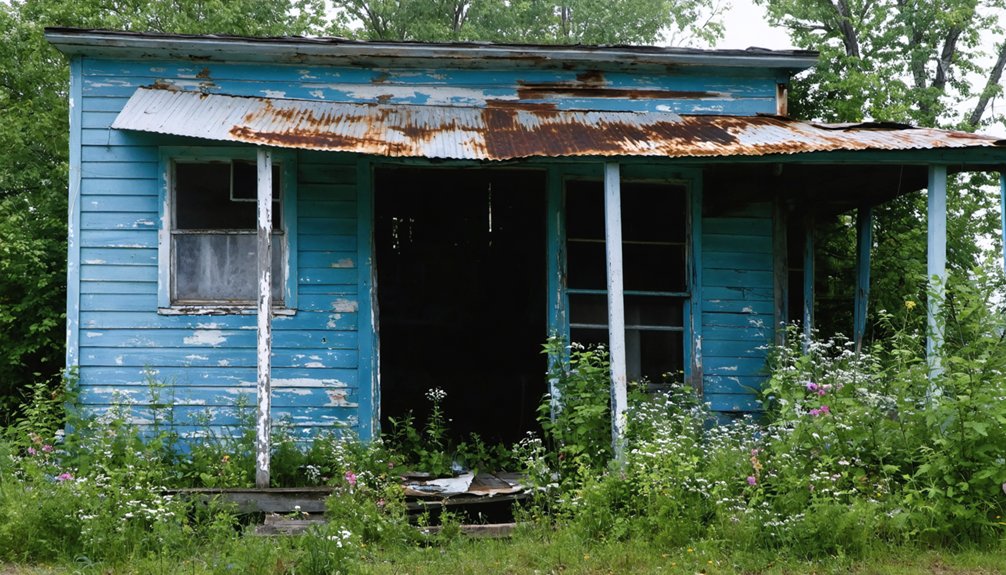
Throughout Baltimore’s abandoned landscape, you’ll find scattered remnants of its historical significance in deteriorating buildings, forgotten artifacts, and weathered infrastructure.
These architectural remnants tell the story of a once-thriving Midwestern community, where daily life played out in now-silent streets and empty storefronts.
- Weathered residential buildings still contain dusty furniture and personal belongings, offering glimpses into past domestic life.
- Old commercial structures stand as silent witnesses to the town’s economic activities.
- Farm equipment and industrial machinery rust quietly among overgrown vegetation.
- Historical documents and photographs preserved in abandoned buildings provide tangible links to Baltimore’s past.
- Original roads and pathways, though largely reclaimed by nature, trace the town’s original layout and community connections.
Ghost Town Tourism Today
While these historical remnants paint a portrait of Baltimore’s past, current tourism to this ghost town reflects broader shifts in America’s travel landscape.
You’ll find Baltimore, Indiana experiencing the same tourism downturn that’s affecting major U.S. destinations. Like many ghost town tourism sites, it’s seeing fewer visitors amid growing safety concerns and changing travel preferences. Urban exploration enthusiasts, who once flocked to such locations, are increasingly sparse.
The site mirrors national trends, where even established tourist destinations are struggling to maintain visitor numbers.
You won’t find the bustling weekend crowds that once characterized ghost town tourism here. Instead, you’ll encounter quieter pathways and fewer tour groups, part of a broader pattern where travelers are seeking alternatives or staying home altogether.
Frequently Asked Questions
Are There Any Documented Paranormal Activities in Baltimore’s Remaining Structures?
You’ll find haunted legends backed by investigators’ evidence, including spectral sightings, shadow figures, EVP recordings, and unexplained physical contacts. Most remaining structures exhibit high paranormal activity that’s deterred prolonged investigations.
What Role Did Native American Communities Play in Baltimore’s Early History?
Imagine vibrant villages along ancient trails – you’d find Native tribes like the Piscataway and Susquehannock thriving here first. They established trade routes, cultural exchange networks, and left lasting legacies in Baltimore’s place names.
Did Any Famous Historical Figures Ever Visit or Stay in Baltimore?
You won’t find any records of famous visitors or historical events involving notable figures in Baltimore. Historical documentation doesn’t indicate any celebrated personalities ever stayed in or passed through this small river town.
Were There Any Significant Archaeological Discoveries Made in the Ghost Town?
You won’t find documented archaeological findings specific to Baltimore’s ghost town site, though nearby areas have yielded historical artifacts typical of pioneer settlements and prehistoric Native American activity.
What Happened to the Town’s Cemetery and Burial Records?
You’ll find the cemetery’s burial records were largely lost as the town declined, with minimal preservation efforts. Today, the site’s registered in Indiana’s Cemetery Registry but lacks extensive recordkeeping of individual graves.
References
- https://www.geotab.com/ghost-towns/
- https://kids.kiddle.co/Baltimore
- http://freepages.rootsweb.com/~gtusa/history/usa/in.htm
- https://storymaps.arcgis.com/stories/9a3b3f4a63ba4031a46cb53907a0515c
- https://en.wikipedia.org/wiki/List_of_ghost_towns_in_Indiana
- https://kids.kiddle.co/List_of_ghost_towns_in_Indiana
- https://www.onlyinyourstate.com/experiences/indiana/ghost-towns-in
- https://www.wikiwand.com/en/articles/List_of_ghost_towns_in_Indiana
- https://en.wikipedia.org/wiki/New_Baltimore
- https://intransporthistory.home.blog/tag/baltimore/
